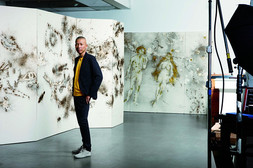 Watching provacateur par excellence Ai Weiwei take a gigantic stand for freedom of expression in China — calling on Western nations for support and, in the process, “threatening to become a cultural figure of serious global importance in the mould of Vaclav Havel and Alexander Solzhenitsyn,” in the words of The Guardian’s critic Jonathan Jones — I was reminded of an interview recently published in the Wall Street Journal’s October-November issue of WSJ. magazine with his colleague Cai Guo-Qiang.
Watching provacateur par excellence Ai Weiwei take a gigantic stand for freedom of expression in China — calling on Western nations for support and, in the process, “threatening to become a cultural figure of serious global importance in the mould of Vaclav Havel and Alexander Solzhenitsyn,” in the words of The Guardian’s critic Jonathan Jones — I was reminded of an interview recently published in the Wall Street Journal’s October-November issue of WSJ. magazine with his colleague Cai Guo-Qiang.
Here’s one excerpt:
In any country, art doesn’t have that much influence to shape things. Sometimes what artists create helps people see other possibilities, which gives them hope. But art is not a tool for social transformation–otherwise it would be the same as how communists used art for propaganda.
And another:
I was using “Peasant Da Vincis” [a 2010 show at Shanghai’s Rockbund Art Museum] to say that China should put more focus on individual creativity of the common people and allow them more freedom of expression. One way of helping Chinese society is allowing people to be able to create freely, not just for China to organize large-scale events like the Olympics or World Expo.
And another:
My main intent behind “Rent Collection Courtyard” [a piece staged in Venice in 1999 in which a 1965 Socialist Realist sculpture was re-created] was how the fate of the artist was controlled or manipulated by politics and its time. At the time of the original work, when the sculptors were making this piece, they were very happy to do so, because they were critiquing the corrupt past and glorifying the new present. But for present-day viewers to look back at this time, you sense this tragedy. You see how gullible the artists were.
Cai clearly has a more nuanced, and somewhat conflicted, view of art and politics.
But Cai makes valid points, worth keeping in mind as Ai plays his dangerous cat-and-mouse game with Chinese authorities. Is Ai too big an art-world presence internationally for him to be arrested for good or seriously harmed (again)? No one really knows.
Photo Credit: Courtesy The Wall Street Journal
